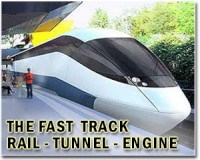| . |  |
. |
Gottingen, German (SPX) Oct 18, 2010 To make railway trains faster and more economical, their shape is decisively important. Two new research facilities at the German Aerospace Center in Gottingen are involved in developing the aerodynamically optimum shape for future rail vehicles. They will be unveiling their work to the public on Friday, 8 October 2010. The tunnel simulation facility is the only one of its kind in the world, and scientists can use it to investigate the ride characteristics of scale-model trains at speeds of up to 400 kilometres per hour. The other facility, for side wind investigations, is also unique. The investment in these two train research facilities amounted to more than three million Euro. "We want to conduct research into high-speed trains with enhanced environmental credentials, with more lightweight construction and higher standards of passenger comfort," explained DLR Director Prof. Ulrich Wagner at the opening ceremony in Gottingen. "We are developing the technologies for the trains of the future, and are demonstrating what lies within the bounds of technical feasibility."
Europe's leading location for research into rail vehicle aerodynamics "This means that the German Aerospace Center is continuing to live up to Gottingen traditions, harnessing its superlative expertise and its new experimental facilities to set new standards for research into the future of high-speed trains at the highest international levels."
Antiquity sets a good example In a similar way, this modern test facility, measuring more than 60 metres in length, catapults scale-model trains up to a speed of 400 kilometres per hour. These trains are built to scales of between 1:20 to 1:100. Using cutting edge measurement techniques, tests are conducted into the aerodynamic behaviour of high-speed trains in a tunnel. A particularly critical moment is the point where a train enters a tunnel. The effect is akin to the piston moving inside an air pump. A pressure wave is created which can give rise to the same kind of explosive noise emissions as supersonic aircraft. The researchers in Gottingen aim to prevent this from happening.
Making side winds into a predictable threat This is why a side wind test facility has been constructed in Gottingen. It can be used to simulate the forces and pressures which side winds can exert on a train. In turn, this guides research into ways of reducing a train's susceptibility to the effects of side winds.
DLR's Next Generation Train Project In this endeavour, DLR scientists are examining a host of issues: how train speeds can be increased while at the same time halving specific energy consumption levels, how to make trains quieter, more comfortable and safer, how to optimise wear characteristics and lifecycle costs, how to leverage modularisation and system integration concepts to build trains more cost-effectively and how to design development and approval processes more efficiently.
Share This Article With Planet Earth
Related Links Institute of Aerodynamics and Flow Technology, Management Next Generation Train Great Train Journey's of the 21st Century
 Saint Barbara stands watch over world's longest tunnel
Saint Barbara stands watch over world's longest tunnelSedrun, Switzerland (AFP) Oct 15, 2010 Burly tunnel workers cheered, clapped and clinked glasses on Friday as the tonnes of rock under the Swiss Alps crumbled away to open a path for the world's longest tunnel. "For miners and tunnel engineers this is the greatest moment in their life, the breakthrough," explained Hans Ehrbar, chief construction officer for the Alptransit tunnel company. But the emotion reached its apogee in ... read more |
|
| The content herein, unless otherwise known to be public domain, are Copyright 1995-2010 - SpaceDaily. AFP and UPI Wire Stories are copyright Agence France-Presse and United Press International. ESA Portal Reports are copyright European Space Agency. All NASA sourced material is public domain. Additional copyrights may apply in whole or part to other bona fide parties. Advertising does not imply endorsement,agreement or approval of any opinions, statements or information provided by SpaceDaily on any Web page published or hosted by SpaceDaily. Privacy Statement |